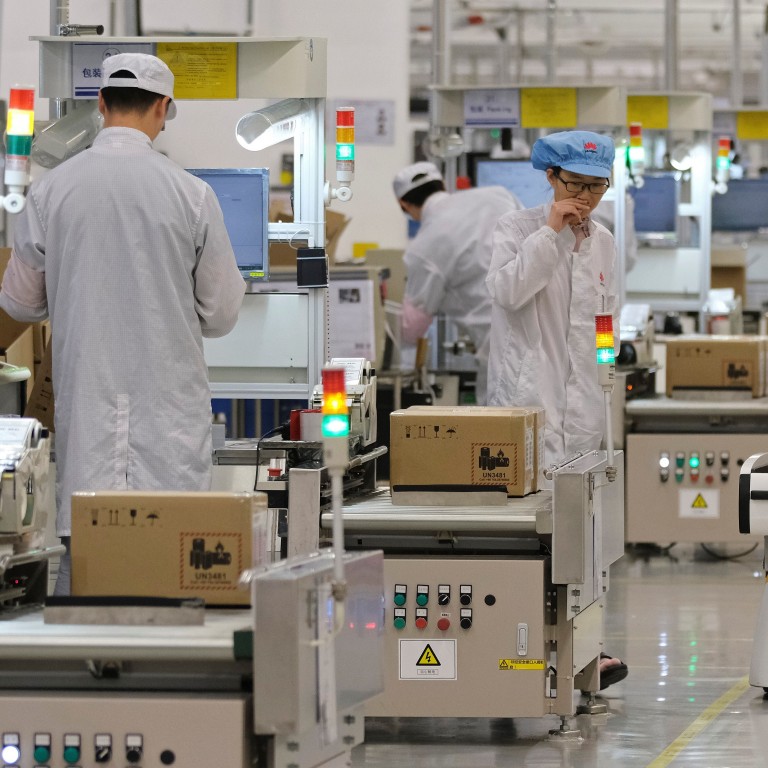
Chinese government subsidies fuel surge in patents but experts warn it’s quantity over quality
- China’s tech giants have been particularly active, with Huawei taking the top spot last year with 4,411 patent applications
- The Beijing government offers as much as 20 million yuan in subsidies for a PCT filing, versus 2 million for a domestic patent
China may have overtaken the US in total number of international patents filed last year, but legal experts warn that much of the growth is being fuelled by state-backed subsidies that could flood the system with cheap patents.
The World Intellectual Property Organisation (WIPO) recently reported that the number of filings by China under the Patent Cooperation Treaty (PCT) totalled 58,990 last year, compared with 57,840 from the US. The UN agency also highlighted that China’s figure was a 200-fold increase in just 20 years.
China’s tech giants have been particularly active, with Huawei taking the top spot last year with 4,411 patent applications. And when it comes to blockchain, Chinese internet giants Tencent and Alibaba together accounted for over 20 per cent of patent filings for that technology last year, according to a report by The Block Research.
Alibaba is the parent company of the South China Morning Post.
Doug Clark, IP lawyer from Rouse & Co and adjunct professor of law at the University of Hong Kong, said China is unlikely to slow its pace of PCT filings because the country still significantly lags behind the US and Japan in terms of patents filed per capita.
China overtook Japan as the world’s biggest holder of domestic patents in 2010 but, after a realisation that those patents do not hold much value, Chinese policymakers moved to incentivise international patents which are typically subject to much more rigorous examination and hold more value.
China becomes world’s top patent filer after four decades with US on top
While the consensus is that more patents are helping improve the country’s record on intellectual property rights – a sensitive issue that has been one factor fuelling the US-China tech war – some are concerned that the government subsidies encourage more low-quality patents.
A study by JZMC Patent and Trademark Law Office and Bloomberg in 2018 found that less than a quarter of new domestic patents in China were new inventions, with the rest being design and utility patents. Further, nearly 91 per cent of new design patents wound up being discarded in five years because patent owners apparently deemed them not worthy of renewal.
Another indication that Chinese patents are deemed less valuable than those in Japan or the US is that they receive fewer citations by non-Chinese researchers, according to Naubahar Sharif, associate professor of public policy at the Hong Kong University of Science and Technology.
In response to the huge numbers of low value domestic patents, the Shanghai government last year raised the maximum annual subsidy for international patent filings from 1 million yuan (US$142,000) to 10 million yuan. Shanghai’s new policy has also cut subsidies for design and utility patents altogether.
The Beijing government adopted a similar approach in the same year. A PCT patent filer is now entitled to as much as 20 million yuan in subsidies versus 2 million for a domestic patent.
Huawei helps China overtake Germany in receiving US patents
Ryan Whalen, assistant professor of IP law at the University of Hong Kong, said China’s subsidies for PCT patent filings encourage individuals and companies to patent technologies with only marginal improvements – repeating the mistakes made in domestic patents.
“Patents in and of themselves, if the underlying intellectual property is valuable, should be a sufficient incentive to push individuals or firms to apply for a patent,” he said, “Subsidies are really running the risk of perverting those incentives.”
Clark said most patent filing subsidies in China were aimed at helping cash-strapped small and medium sized companies – rather than big tech corporations. As such, he believes the spike in the number of patents filed by big tech companies is a sign of China’s growing technological prowess and the major shifts taking place in areas such as telecommunications and biotechnology.
Sharif said that the patent subsidy policies were fuelling innovation in China and that, in turn, would create momentum for Chinese patents to gradually move up the value chain.
In a statement to the Post, Huawei said its lead in PCT applications was fuelled by the company’s “consistent investment in R&D,” which represents 10 to 15 per cent of its revenue.
“Huawei has been leading Chinese companies in the number of patents filed since 2002, rivalling other multinational companies,” the statement said.
On the issue of subsidies, Huawei said it was a practice common to various countries and that it has “enjoyed the support of China’s patent filing policies just like other patent filers.”
Tencent and Alibaba did not immediately reply to a request for comment.
Erick Robinson, patent litigator at Dunlap Bennett & Ludwig, said another factor in China’s patent surge was the increasingly robust IP court system that has bolstered the value of patents in Chinese courts.
“Patents are only valuable in that you can get more money out of a patent through licensing and litigation,” Robinson said. “I’d argue that you can get more money out of licensing and litigation in China now than you can in the United States.”
“People still have this perception that you can easily get away with infringements in China but the reality is that it is no longer the case.”
Sign up now and get a 10% discount (original price US$400) off the China AI Report 2020 by SCMP Research. Learn about the AI ambitions of Alibaba, Baidu & JD.com through our in-depth case studies, and explore new applications of AI across industries. The report also includes exclusive access to webinars to interact with C-level executives from leading China AI companies (via live Q&A sessions). Offer valid until 31 May 2020.

